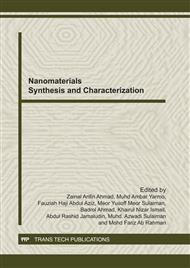p.450
p.455
p.460
p.465
p.470
p.475
p.480
p.485
p.489
The Optical Properties of Ammonia Treated TiO2 Nanostructure Prepared by Liquid Phase Deposition Method
Abstract:
. TiO2 was known for its potential in solar cell and photocatalyst application. However the usage of anatase TiO2 in solar cell application has its own disadvantage as TiO2 spectrum was limited to ultraviolet (UV) light limiting its application. It was found that the broader optical absorption of TiO2 can be obtained by nitrogen doping. This paper report the optical properties study of ammonia treated TiO2 nanostructures with various percentage concentration of ammonia. The TiO2 nanostructures was prepared by liquid phase deposition (LPD) method using on ITO substrate and annealed at 450 °C for 1h. The TiO2 nanostructures were characterized with rod-like morphology with length and diameter of ca. 100 nm and ca. 100 nm respectively that vertically oriented on the surface. The optical properties of the samples exhibit strong band near the UV region. The optical properties drastically changed if the samples treated with ammonia, of which exhibit the present of broader absorption band in the visible region. The TiO2 treated ammonia should be find used in photoelectrochemical (PEC) solar cell application.
Info:
Periodical:
Pages:
470-474
Citation:
Online since:
October 2011
Price:
Сopyright:
© 2012 Trans Tech Publications Ltd. All Rights Reserved
Share:
Citation:


